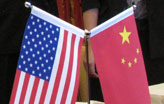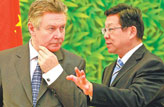From Chinese Press
RMB internationalization well underway
Updated: 2011-07-18 16:46
By Tian Li (peopledaily.com.cn)
2011 marks the 10th anniversary of China's accession to the WTO and the second anniversary of the official launch of cross-border RMB trade settlement. The country has made rapid progress in opening up in the past 10 years, and foreign trade has become the largest driving force behind its economic growth. Based on strong worldwide demand for Chinese products, the internationalization of the RMB is well underway.
Solid foundation laid for RMB internationalization
"This is a historic breakthrough. When you look back at the cross-border RMB trade settlement some time later, you will find that this moment is destined to be recorded in history," economist Xie Guozhong said in July 2009 when the People's Bank of China, the country's central bank, announced a trial run of cross-border RMB trade settlement.
Cross-border Renminbi trade settlement has witnessed explosive growth in just two years and has expanded to 144 countries and regions, laying a solid foundation for the RMB internationalization.
Li Bo, director of the Monetary Policy Department under the People's Bank of China, said that China has made considerable progress in the internationalization of the RMB in the past two years. First, total cross-border RMB transactions hit 500 billion yuan in 2010, accounting for about 2 percent of China's total export and import volume. Such transactions reached 530 billion yuan in the first four months of this year alone, more than the total for all of 2010.
Second, a pilot RMB cross-border investment and financing program has been launched, with the scale reaching 19 billion yuan. Third, foreign companies make direct investments in China using the RMB. Furthermore, China has signed currency swap deals with a number of its trading partners, introduced the RMB backflow policy and fostered the development of the RMB business in Hong Kong. So far, China has signed currency swap deals with South Korea, Hong Kong Special Administrative Region, Malaysia, Belarus, Indonesia, Argentina, Iceland and Singapore involving a total of 803.5 billion yuan or more than 120 billion U.S. dollars.
Risk control
Preventing huge imports, exports of speculative capital
While the cross-border flow of the RMB is strengthening, Chairman of the China Banking Regulatory Commission Liu Mingkang said that China should prevent the possible negative impacts caused by huge imports and exports of speculative capital. Some countries have adopted the Unremunerated Reserve Requirement and some have started to collect income taxes of foreign investments or financial transaction taxes. These methods or measures are all very good for China to use for reference.
An official from China's central bank said that in order for the RMB to "go global," the steady growth of China's economy and comprehensive national strength must be the foundation, and while China maintains steady policies and improves its macro-economic management capacity, it must prevent radical changes to its economy.
The official emphasizes that the internationalization of the RMB must be greatly supported by reforms of domestic economic systems. "For example, the reform of the RMB Capital Account Liberalization must be promoted in an orderly fashion. If capital and demand are restrained in all aspects, the development will be certainly slow. Under the current conditions, the choice between RMB and foreign currencies should not be decided by administrative policies but should be decided by economic entities according to their will and interests."
Steadily achieving RMB internationalization in three steps
The remarks made by China's National Council for Social Security Funds Chairman Dai Xianglong during the "Second Global Think Tank Summit" hosted by the China Center for International Economic Exchanges have attracted widespread attention. He said, "China's GDP and foreign exchange reserves account for 10 percent and one third of the world's total respectively, and China is the world's largest financial creditor country, so that China's RMB will naturally become an international currency. This will benefit not only China but also the improvement in the global monetary system."
He said that the internationalization of the RMB could be divided into three steps. The first step is to make the RMB an international trade settlement currency based on the convertibility of RMB on the current accounts. The second step is to turn the RMB into an investment currency by allowing certified investors at home and abroad to jointly promote the two-way flows of the RMB. The third step is to achieve the internationalization of the RMB and turn the RMB into an international reserve currency.
Li Daokui, an adviser to the Chinese central bank, recently said in an article, "The strategic objective of the internationalization of the RMB is to enhance the international status of the Chinese economy, improve the stability of the world economy and benefit the Chinese economy during the process. The internationalization of the RMB will perhaps become a grand trend for the world economy over the next decade as well as a major development trend for China over the second decade after its accession into the World Trade Organization."

Specials

China-US Governors Forum
The first China-US Governors Forum is held July 15 in the Salt Lake City, the United States.

My China story
Foreign readers are invited to share your China stories.

Rare earths export quota
China kept its export quota at almost the same level as last year.